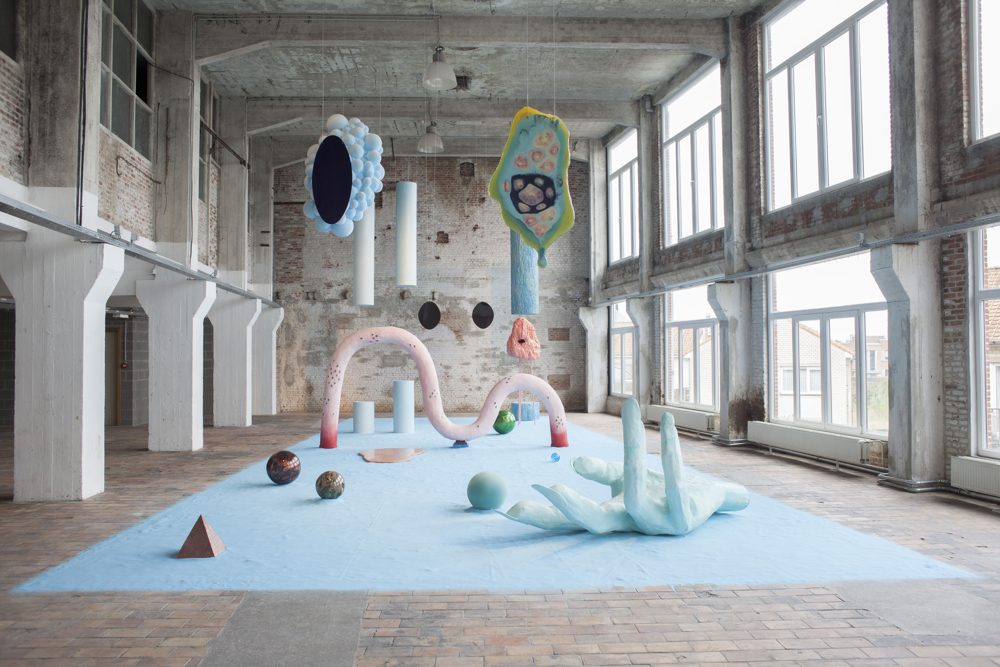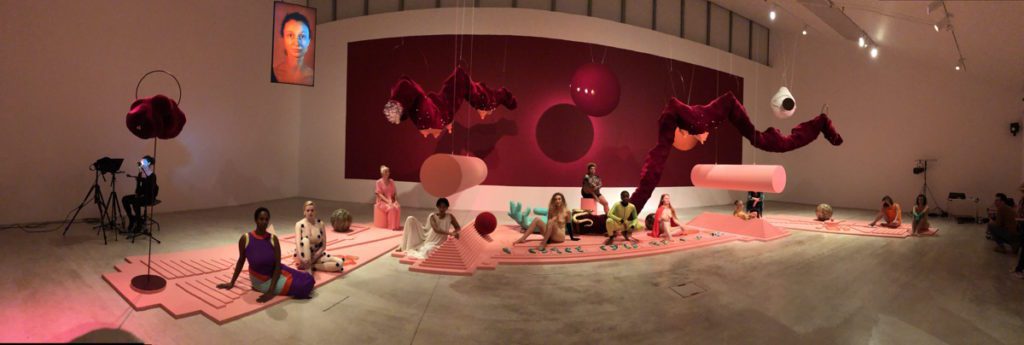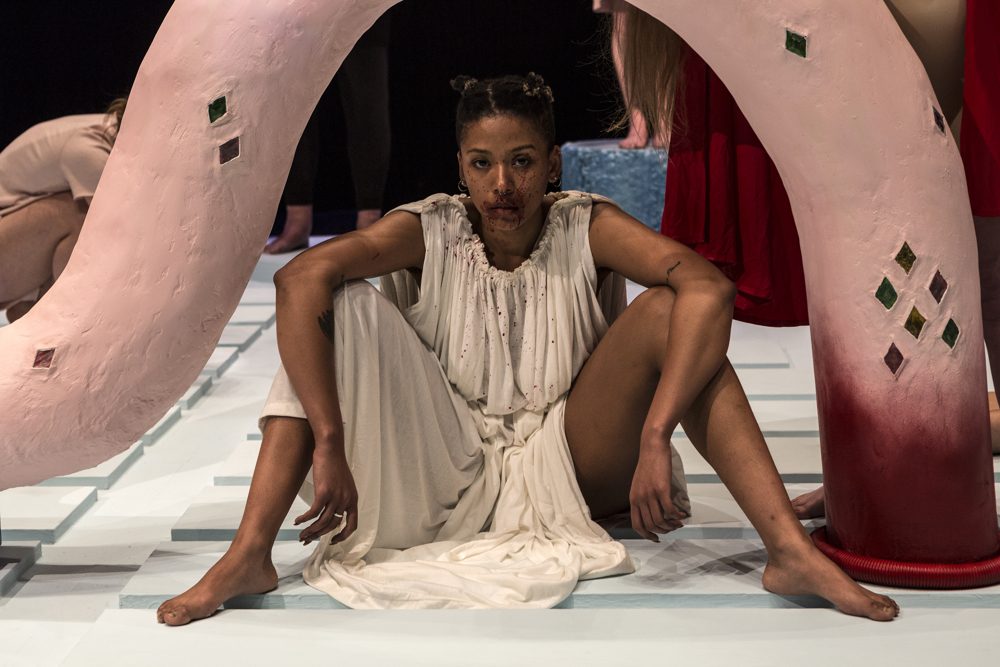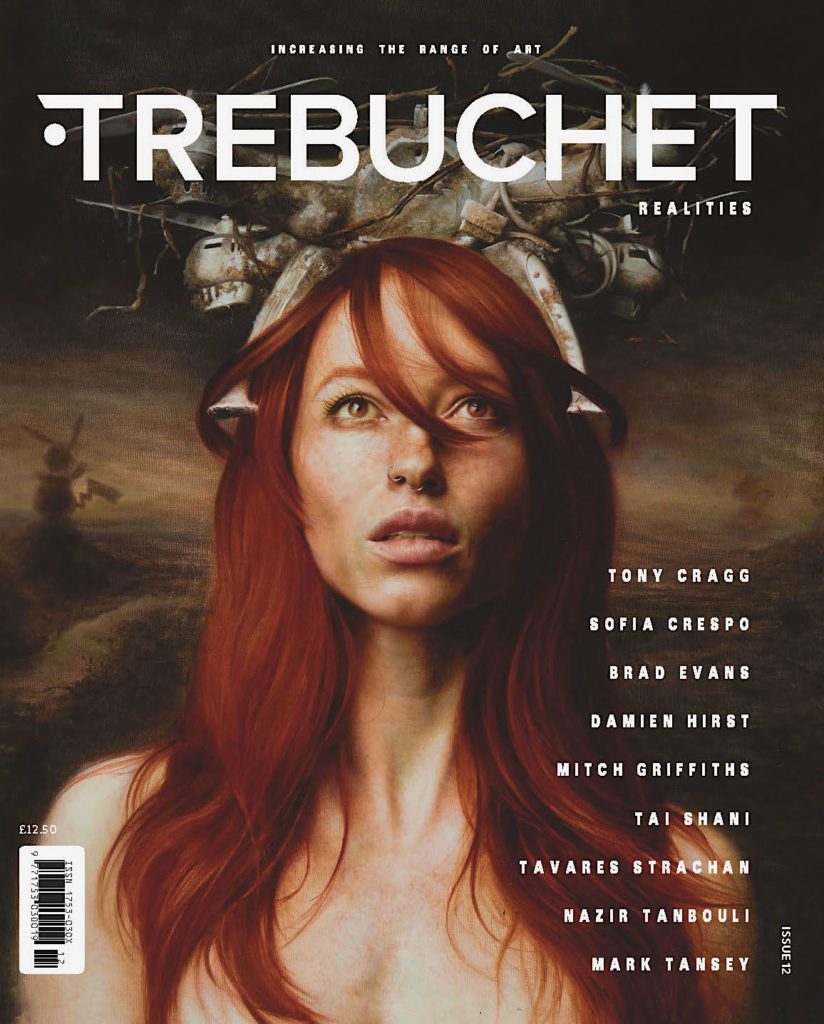In 2019 the Turner prize was shared between Lawrence Abu Hamdan, Helen Cammock, Oscar Murillo and Tai Shani. The jury supporting the artists wishes ‘to use the occasion of the Prize to make a collective statement in the name of commonality, multiplicity and solidarity – in art as in society.’ (Artist statement Turner prize 2019). These are themes which resonate with the artist Tai Shani, whose multidisciplinary work combines performance, film, photography and installation to create a palimpsest of stories describing a feminine cosmology.
Shani’s work suggests that reality consists of various positional layers of meaning and that, while we can have a focus, the context is always in flux, the fantastic richness of which transports us from the present and into a drift between times, testimonials, and mediums. Tai Shani’s submission for the Turner Prize, DC: Semiramis (2014-2019), presented an expanded adaptation of Christine de Pizan’s 1405 manuscript, The Book of the City of Ladies. The city is an abode for notable women drawn from across the mediaeval conception of history. Shani’s version of these characters layers fact, fiction and myth amongst sculptural and dramatic elements. It asks the viewer to question their construction of their history, how they see the present, and what that means as a nexus of collective and individual association. It invites us to consider what that means for us, the viewer, as an agent of creation, oppression, liberation, and solace.
Shani’s 2022 collaboration was a precursor to Art Night’s transition to a national, biennial contemporary art festival, with the first new festival planned for 2023 (artnight.org.uk). Ahead of the first performance at Fabric in London Shani spoke to Trebuchet about the then nascent work and the abundance of material that inspires her.

Researching your practice and history, I was struck by how your approach to feminism has changed. Can you expand talk us through that journey?
Yeah definitely, femininity is important and certain modes or dynamics around othering are important in my work. but I don’t think that these are tied to biology. And that’s what changed in my thinking around gender. My earlier stances were just to do with ignorance, really.
I don’t think I was always a feminist. When I was young I had a kind of Stockholm Syndrome within patriarchal modes of sexuality and gender. I was very much in the thrall of that and I couldn’t see outside of it. So it’s been a process of coming outside of that. Which is not something that happens overnight, maybe for some people or they’re lucky to grow up with that information around them. I wasn’t.
The way my parents brought me up to think around gender was you don’t have to think of yourself as gendered. They were radical people, so they said you don’t have to think of yourself as a woman in a traditional sense.. We’re Jewish and my family was very anti-religion, and my parents would say we’re planetary citizens. It’s great to have that inside you but you have to find ways to break down how you interface with a world that decidedly does see you in that way. That does see you along the lines of race, gender, class, all these things.
So that’s when I started to educate myself about gender specifically and where I found a certain sense of empowerment in the fact that I felt that there was something essential about femininity. That there was something essential that was tied in with female biology, that having a womb or having whatever biological traits meant something at that point. That is something that I’ve educated myself and completely changed my position on. , experiences of the body are way more complicated. For me there was this growing shift that was simultaneously cannibalising interesting things about feminism, but also around what was happening societally which was becoming very exclusionary to trans women. The basis of my politics is the idea that it has to be completely non exclusionary. If not, it is not constructive; they reproduce forms of oppression, and division, isolation and brutality. It was important for me to recognise that and part of my political self education was to have the realisation that if you’re interested in any form of liberation or emancipation that involves the subjugation of another group, it’s counter revolutionary.
I think that a lot of the trans exclusionary stuff is violent. It’s very brutal towards not just trans women but towards people that support them. It’s a strange movement and what’s been interesting is how some of them are realising that the people that side with them are people on the right, they’re not left.
That often happens around specific topic led protests. You might find yourself marching alongside people you’d otherwise disagree with.
A criticism of the Left you often hear is that there’s constantly infighting. I think that’s a good thing because it’s about having a high standard of what you think is right. For a lot of people on the right, hating a group of people is a common enough denominator for the right?
For your new show at Fabric can you give us a bit of background and how this progresses your ideas?
It’s very fresh and it hasn’t happened yet – so fresh it’s still baking! So it’s a little bit difficult to talk about at the moment but I guess I can talk about the aspirations for the piece, not what it succeeds in doing or not, because we’re not even in rehearsal yet.
Once I was finishing ‘DC: Semiramis’ (circa 2018) I moved on to a different project that’s called ‘The Neon Hieroglyph’ that I’ve been working on for three years now. At the same time I’ve got a show at a new gallery called Gathering that opens on the sixth of October, which is also a culmination of that project. So I’m mentioning that project because it also talks about how I got here.
With (2019 Turner prize winning) DC: Seminiramis I was fortunate for receiving a lot of accolades for that project and because of that it went on a bit longer than I anticipated. I had planned that the piece would end in 2018 with the 12 performances in Glasgow. That was to me the end of it. And then I was incredibly fortunate to be nominated for the 2019 Turner Prize And so I presented it again, revisiting it, so it had a bit of a longer life than I planned.
But at the end of that extended run I wanted to take a break from that project. Partly because it has a particular structure to it. And sometimes I do wonder, that i could have continued using that structure, because the building of a city – I call that a ‘city in time’, not ‘in space’ – it could last your whole lifetime. You could focus on different things and it can hold in anything you do. Because any project you want with any line of inquiry, any project, you can somehow find a way to fit it into (the space I conceived of as a) city. So, there was part of me that wondered whether I should stick with this idea of the building of the city?

But then I felt there were things that I wanted to change in my work. I felt quite strongly that I wanted to move away from having this very declarative voice of ‘this is feminism come with me, let’s build the city’ rather, I felt ,there were more urgent and relevant voices to talk about that intersection specifically. So I did an intermediary project which was called ‘Tragodia ’ which was about a family and was very much autobiographical. But again, it could have been a family in the city because it’s very easy to fold any structure into there.
Initially I didn’t want to work on long term projects, and then, of course, I ended up working on a long term project. I suppose even though they feel long term in the present, if you look at someone’s lifetime, working on something for three years isn’t really that long term?
If that’s the case why did it take five years to prepare for DC: Semiramis?
It’s a question of gestation and also it was just a question of necessity. I wanted to do this big project, but I wasn’t at a point where I was trusted with the resources needed to do that. So over the years every time I was offered an opportunity, I did one of the characters or an iteration of one of the characters that built up the project over time.
Plus there were a number of themes I wanted to address in The Neon Hieroglyph; I grew up in a psychedelic community and I wanted to probe that a little bit. I have this question in my mind about my imagination and how it works, how my cognitive structure works. I took drugs at a very young age so I have this question around how formative they were in shaping my cognitive structure. My dad had the story about how I was conceived on mescaline and so it was in my DNA from the get go. Also there are certain kinds of social dynamics that are quite circular and I wanted to work out how cultures merge in at certain points and how things fail.

So that was the background to The Neon Hieroglyph is about the very speculative history of ergot, a fungi that grows on rye and LSD is derived from. I decided to just write this very poetic, speculative, feminine/feminist history of Ergot.. I was contacted by Art Night and Museum of London and I thought about how I could expand on the politics in this project that were becoming more explicit and urgent to me.
So My bodily remains, your bodily remains, and all the bodily remains that ever were, and ever will be. (Down, skin, pelt, vellum, alert tangled roots, subcutaneous flesh, subterranean blind life) talks about fascism and the state. You asked me about the role of the fantastical in the political arena. One of my best friends is a filmmaker called Pia Borg years ago said about how at the beginning of cinema, you had George Méliès and the Lumiere brothers. While the Lumière brothers are the ancestors of documentary, realism and social realism in filmmaking about reaching a truth, Méliès was about the fantastic. So there’s always been that tension around what is a better way to think about what’s the better way to to produce some form of truth. Is it a replication of reality? Or is it an analogy or an analysis of that reality? Or is it about somewhere completely elsewhere, where certain dynamics can be very made more explicit than they are in, let’s say, realistic setups. That is often been a focus for feminist science fiction, in creating worlds where there are different dynamics that you can then use to critique the ones of our society. Satire has also done that and been very lucid about something specific.
You talk about ‘producing truth’ is that opposed to finding it. Are there truths that are there to be discovered? Do you think there are factual things that are indisputable? Or is there always a production?
I believe in justice. justice Is a truth and maybe, semantically speaking, that is also spiritual. It extends beyond the rhetoric and beyond the subjective position. There is a truth there and that is something that I definitely hold onto in my life. I try to be very clear about what my orientation towards justice says to myself. That does create truth. On the one hand, it can be complicated and some people talk about how certain situations are complicated. But I often don’t think it is. I always see it quite clearly. And people do see it clearly. Which is sometimes inconvenient.
But it’s there. And that is a truth. So if you’re trying to think about ways to be more equitable, despite whatever platform or discipline you use, you need to consider that your life is a miracle. I’m not religious, but a life is a miracle and if you think that there are people that are born into conditions where that can never be understood, or that they’re never treated in that way then that is the opposite of truth. That is a huge lie. Do you see what I mean? And that has to be counted?
In any, western country, you have poverty, you have people that are excluded. We do live in a wealth-apartheid world in the West and we live in a reality-apartheid world politically, those are two kinds of separation. By reality apartheid I mean that a lot of the culture wars that we’re seeing being fought at the moment comes down to a fundamental question (of whose vision of reality is considered valid). There is an increasing view through education or whatever that everything is constructed, everything is socialised, so we could also live completely differently. At the same time the conservative view believes we live in a natural order, there is a tendency to find an analogy in the natural world and say that that is natural for us too like hierarchy. But it’s arbitrary. for any social organisation in nature that is hierarchical, you’ll find one that’s collaborative.
The thing is that ideologically, hegemonic ideology will look for models that are replicated in nature that support their ideology, but you could choose a completely different set of structures in animal or plant life that support a completely different way of being. However, there’s a stake in the idea that the status quo is natural and that inequality is natural, that ownership is natural, but it isn’t. It really, isn’t property is not a natural thing at all. It doesn’t exist in this extreme form anywhere apart from within human society. So when we’re talking about reality-apartheid it’s how people in power feel the status quo is not just normal but natural. So on one hand you have people who feel there is a natural world that they’ve grown up in where certain people have more power, and there’s an amassment of power that centralises certain groups and certain categories of people. And that that is a reflection of nature.
On the other hand, you have people that think it’s all up for redefining, none of this is natural. So we could also choose a much more equitable, fair way of living, that, people can live for pleasure, people can live for the things they enjoy, that don’t think wage slavery is a reality. It’s not natural. So a lot of the culture wars are about that, aren’t they?
So going back to transness, a lot of TERFS (Trans Exclusionary Radical Feminists) think that biology is natural and the the end of story. But you can also find, transness, in nature, transness exists in nature. I find it fascinating that people that think we live in a natural order. They’re very selective about when it’s natural or when it’s not. Then they’ll say ‘Oh, but we’re human. We’re different, humans are different’. But if that’s the case then let’s do everything.
Which is part of what the play works with. The play s told through three characters; there’s ‘the ghost for revolution’, there’s ‘them who loved one’, and ‘them who love two’ and a live score by Maxwell Sterling and Richard Fearless. And then there’s the Book of Love, which is an object at the moment, but it might become a character in ‘the book of love, is just full of quotes. Historical quotes from thinkers, revolutionary thinkers, people that were part of political groups, and ithe ‘Book of Love’ shows that radical thinking has always been there. It’s not a new phenomena, it is a tradition. It’s just that we’re always made to feel that we’re starting from zero whenever the movement coalesces against the state or, right wing politics, conservative politics, but it’s something that’s been there for hundreds of years. It’s as old as time itself, revolutionary thinking, and (ironically) the ideas haven’t changed that much. They’re always about equality. There’s actually nothing radical about equality. It is basic, and that’s what it should be. It should be basic thinking. So in the Book of Love, there’s a lot of quotes by people like Lucy Parsons, who was a black woman anarchist that was very fundamental to anarchist thinking. But she’s someone that outside of more radical left circles you wouldn’t have heard of because anarchism as a movement has been pretty much written out of history, whereas it was in fact a huge movement and was highly influential.
So that’s also part of the play as well. It asked what is it that gets left out? It’s not just voices, it’s entire movements. It’s entire organisations that were very active and successful in thinking of ways that we could live better, destroy capitalism, be inclusive, love. So the play is about love and includes the history of radical thinking. Though in a very poetic and speculative way because it’s a short play. The play runs for about an hour.
The ghost for revolution talks about very somatic experiences of violence, state violence , and fascism. ‘Them who love’ are these two characters that that love each other, but they also talk about love, a lot, in a very expanded form and also as a cue to think of it love in a powerful way. and I don’t mean that in a powerless, wishy washy, ‘peace and love, man’, way. But at the same time it asks the questions about why these slogans are discredited so much? It’s because there is actually a power there. Which boils down to an acceptance that even if you’re not culturally similar, or want to be best friends with someone, loving the fact that they also have the right to a dignified life is love.
How do you define your work? Is it a theatre performance? Is it a tableau? Is it a happening in a Beuysian Sense?
Well, the one I was just talking about My bodily remains, your bodily remains, and all the bodily remains that ever were, and ever will be. (Down, skin, pelt, vellum, alert tangled roots, subcutaneous flesh, subterranean blind life) I think of as…
Read the article in full now in the latest issue of Trebuchet, or come back next week for part two.
Read more in Trebuchet 12: Realities
Tavares Strachan, Nazir Tanbouli, Sofia Crespo, Mark Tansey, Nathalie Djurberg & Hans Berg, Mitch Griffiths, Tai Shani, Brad Evans, Tony Cragg, Damien Hirst, and Jake & Dinos Chapman
My bodily remains, your bodily remains, and all the bodily remains that ever were, and ever will be. (Down, skin, pelt, vellum, alert tangled roots, subcutaneous flesh, subterranean blind life), will be performed by Tai Shani at Artnight 2023, Dundee on the 24th June 2023. Further details artnight.org.uk
All images courtesy of Tai Shani

The aim of art is to represent not the outward appearance of things, but their inward significance. – Aristotle




















